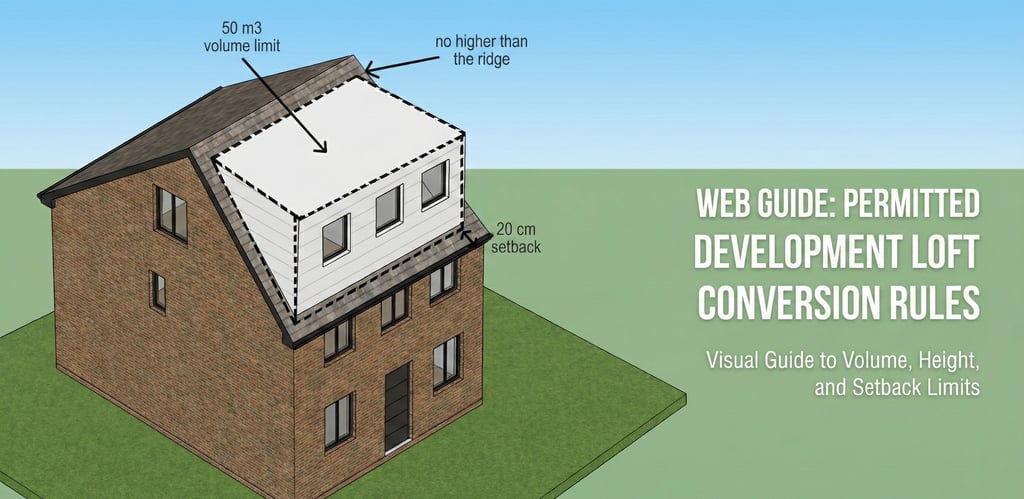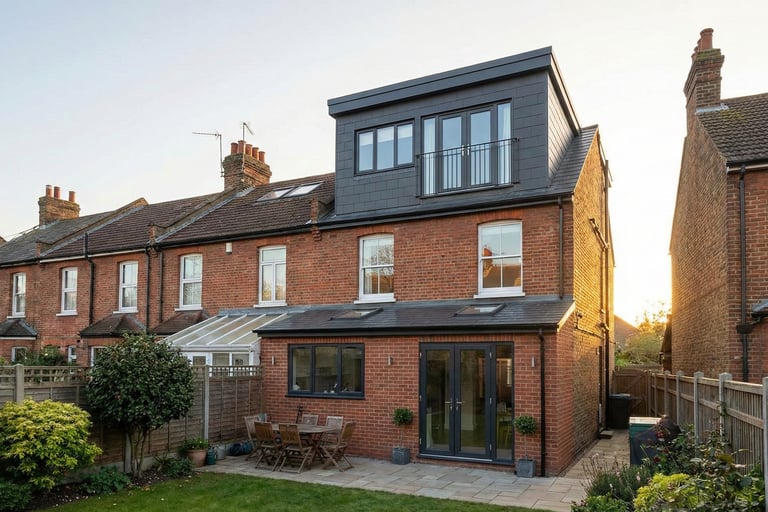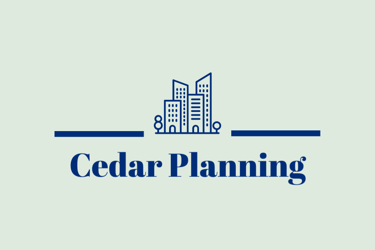Understanding Planning Permission for Loft Conversions
Loft conversions can be an excellent and cost-effective way of adding space and value to your home. But you may be wondering if you need planning permission for a loft conversion. Read below to find out more.
9/22/20256 min read


Do I Need Planning Permission for a Loft Conversion?
Are you considering converting your loft to provide you with some much needed extra space? You may be asking yourself 'Do you need planning permission for a loft conversion?'. Throughout this blog post we seek to provide you with some help answering that question, but if you need any direct assistance please get in touch.
In some cases, loft conversions do not need planning permission, but this will depend on the specific circumstances of your house and proposed build.
We cover:
What are Permitted Development Rights and why are they important for your loft conversion project?
The size of your loft conversion.
Location of your loft conversion.
Other important considerations.
If you are considering a loft conversion for your home, and want a free consultation and no-obligation quote for our planning services, please click the button below to contact us.
Permitted Development Rights
In England, homeowners can do a variety of works to their property through something known as "permitted development rights", which means that planning permission is often not needed. These rights apply to various types of developments, including extensions, loft conversions and outbuildings.
One of these rights is Class B Permitted Development Rights which allows for alteration of roof spaces to provide for a loft conversion. This can be used for rear dormer loft conversions and hip to gable loft conversions. If you are simply converting the loft space and not changing the size or shape of your loft, you can often do this without planning permission or permitted development rights. Rooflights can often be provided in a property through a separate Permitted Development Rights - see our blog post for more information.
The Permitted Development Route is favoured by homeowners across the country who want to avoid the detailed considerations of planning policies matters, such as design matters. However, Permitted Development Rights do not apply in all circumstances, and as such it is important to check with a suitably qualified planning consultant prior to commencing work. We cover the important considerations below.
Size Restrictions
When it comes to the size of your loft conversion, Permitted Development Rights limit the space to be provided. This is calculated as the additional roof space provided by the loft conversion (in cubic metres) rather than the floorspace you provide as a result of your conversion. The cubic content of the new roof space cannot exceed the following:
40 cubic metres of new floor space for terraced houses;
50 cubic metres for semi-detached or detached houses;*
*As a reminder, Permitted Development Rights do not apply to flats or mixed use properties
The cubic space of your loft conversion will take into account the 'original dwelling' as the baseline. This means that although you haven't made any additions to the main roof of your property, if previous owners of your house have done, this will need to be taken into account.
The Permitted Development Rights for loft conversions also state that any part of the house cannot exceed the highest part of the existing roof. This means you cannot increase the highest point of your roof at all, or have a dormer which is higher than the highest part of the existing roof. This is measured against the 'original' dwellinghouse, so will take into account any alterations done by a previous owner.
Location
Permitted Development Rights are restricted in certain sensitive locations, such as Conservation Areas, World Heritage Sites, National Parks, Areas of Outstanding Natural Beauty (now called National Landscapes) or the Broads. Within these areas you will need to apply for planning permission for alterations to your roof.
Permitted development rights for loft conversions do not allow for works which would project forwards from a roof slope of the principal elevation of the house (commonly the front of the house) and front a highway. In practice this means that any alterations to your roof will need to be to the rear of the property to comply with Permitted Development Rights, and any alterations to the front of the property would need planning permission. However, rooflights can still be installed on the front side of your house, subject to limitations and conditions.
Planning Conditions
A number of Councils across England are using, and have used, planning conditions or Article 4 Directions to remove Permitted Development Rights. If these have been removed you will need planning permission for a range of works which would otherwise be allowed under Permitted Development Rights. This information can usually be gathered from your local Council website. Often Article 4 Directions are applied in certain sensitive areas, or new build housing or estates so the Council can control development by determining planning applications.
If you live in a flat, it is important to remember that permitted development rights only apply to houses. Similarly, if your home was converted from a commercial use using a change of use permitted development right, such as Class MA, permitted development rights do not apply to your home. Therefore, if you want to make changes to your flat, you will need planning permission.
You will also not be able to make any alterations to the roofspace of the property if your property has previously been extended upwards using a Permitted Development Right called Class AA.
Other alterations
Other associated works such as verandah's, balcony's and alterations to chimneys or soil pipes are covered by other permitted development rights.
Permitted Development Conditions
If your proposed loft conversion meets all of the limitations above, your proposal will also need to meet a range of conditions which govern the size and materials to be used.
Importantly:
materials for the external work must be of a similar appearance to the existing house;
other than in the case of hip-to-gable extensions, the eaves of the roof are maintained or reinstated; and the edge of the enlargement cannot be less than 0.2 metres from the eaves;
other than in the case of an enlargement which joins the original roof to a rear or side extension, no part of the enlargement extends beyond the face of any external wall of the original dwellinghouse;
any window inserted on a wall or roof slope forming a side elevation must be obscure glazed and any openings must be 1.7 metres above the floor.
What is a Lawful Development Certificate?
If you wish to proceed with a loft conversion, we recommend seeking a Lawful Development Certificate or Certificate of Lawfulness from your local Council. This confirms that your works are in line with permitted development rights.
This can give you peace of mind, ensuring that if your works are carried out in accordance with your plans, your works will be immune from enforcement action. It also acts as valuable confirmation for any perspective purchasers of your property when you come to sell your home.
Cedar Planning are experienced in gaining successful Lawful Development Certificates for our clients.
What if my proposed loft conversion doesn't comply with Permitted Development Rights?
If your proposed loft conversion doesn't meet Permitted Development guidelines, you will need to apply for planning permission from your local council. Whilst this doesn't necessarily mean that your proposal will be refused, it can often limit the changes to a home, as many councils take a dim view of large box dormer extensions.
If you are required to apply for planning permission, your local council will asses your works against the relevant planning policies and guidance. Whilst this varies from council to council, in general you will need to pay attention to any design guides produced by your council, and look to minimise any potential design impacts. Some examples of good design guides that include dormer extensions include:
Reading - https://images.reading.gov.uk/2019/12/Design-Guide-to-House-Extensions-SPD-adopted-March-2021.pdf
York - https://www.york.gov.uk/downloads/file/2804/house-extensions-and-alterations-draft-spd
Whilst each Council will have their own rules and regulations to follow, the three examples above demonstrate that if you need planning permission, in general dormer extensions will need to be smaller than would otherwise be allowed under Permitted Development Rights.
Building Regulations
In addition to planning permission, you will also need to comply with building regulations when carrying out a loft conversion. Building regulations are a set of standards that ensure the safety, accessibility, and energy efficiency of a building.
Building regulations for loft conversions cover various aspects, including:
Structural stability
Fire safety
Insulation
Ventilation
Staircase design
Sound insulation
It is essential to obtain building regulations approval for your loft conversion to ensure that the work meets the required standards. This approval can be obtained from either the local authority or an approved private building control inspector.
Conclusion
Before embarking on a loft conversion project, it is crucial to determine whether or not you need planning permission. In many cases, loft conversions can be carried out under permitted development rights. However it is recommended that you seek a Certificate of Lawfulness or Lawful Development Certificate from your local council.
If your loft conversion does require planning permission, you will need to submit a planning application to your local authority. Some councils take a negative view of loft conversions, so if your works comply with permitted development rights, the lawful development certificate route is always preferred to a planning application.
In fact, Cedar Planning have dealt with cases where planning permission was refused for a proposal which was then found to comply with permitted development rights as confirmed by a Lawful Development Certificate granted by the Council. Contact us today for a free no-obligation quote.
By understanding the planning permission requirements and building regulations for loft conversions, you can proceed with your project confidently and ensure that it is carried out legally and to the highest standards.


Need Expert Advice for Your Loft Conversion Project?
Use the form below for a free initial appraisal of your project, or alternatively email info@cedarplanning.co.uk
Contacts
Email: info@cedarplanning.co.uk
Phone: 07418 610156
Office (by appointment only) Cedar Planning Ltd, 82a James Carter Road, Mildenhall, Bury St Edmunds, IP28 7DE


Click the above button for a free Whatsapp consultation

